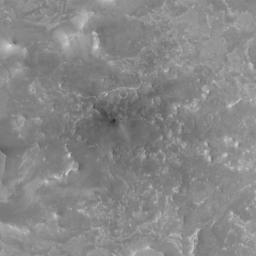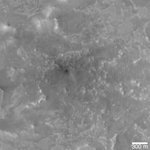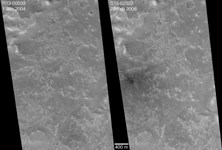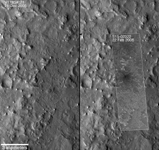Pictured here is the second of 2 of the 20 new impact craters identified by the Mars Global Surveyor (MGS) Mars Orbiter Camera (MOC) science operations team to have formed between May 1999 and March 2006 that occur at a location that the MOC narrow angle camera imaged previously. This is surprising, given that the narrow angle camera, with its 3 kilometer- (1.9 miles)-wide field of view, has only covered about 5.2% of the martian surface. The other such case is described in an accompanying release, "One of Two Fresh Impact Crater Sites With Before and After Narrow Angle Mars Orbiter Camera Images" (see PIA09023 or MOC2-1614).
Figure A: This picture shows the impact site. It is located in Arabia Terra near 25.8°N, 308.0°W. The figure is a composite of sub-frames of MOC images S15-02322, obtained on 22 February 2006, and S17-01393, from 17 April 2006. The largest crater at the center of the impact zone has a diameter of about 16.0 ± 1.7 meters (about 52 feet). Several other smaller craters were formed by this impact event.
Figure B: This figure shows how the impact site appeared in a previous MOC narrow angle camera image, R13-00039, on 1 January 2004, before the impact occurred. This is compared with MOC image S15-02322, obtained after the impact.
Figure C: This figure shows the impact site as it appeared to the Mars Odyssey Thermal Emission Imaging System (THEMIS) visible camera on 21 December 2005. Most importantly, the crater did not exist on 21 December 2005, but the dark spot the impact produced was seen 42 days later in MOC red wide angle image S14-03311 on 31 January 2006. In other words, the impact occurred between 21 December 2005 and 31 January 2006. It is possible that the crater formed in January 2006, after we began our survey for fresh martian impact craters!
The Mars Global Surveyor mission is managed for NASA's Office of Space Science, Washington, by the Jet Propulsion Laboratory, a division of the California Institute of Technology, Pasadena. Lockheed Martin Space Systems, Denver, developed and operates the spacecraft. Malin Space Science Systems, San Diego, Calif., built and operates the Mars Orbiter Camera.
For more information about images from the Mars Orbiter Camera, see http://www.msss.com/mgs/moc/index.html.

 Planetary Data System
Planetary Data System















